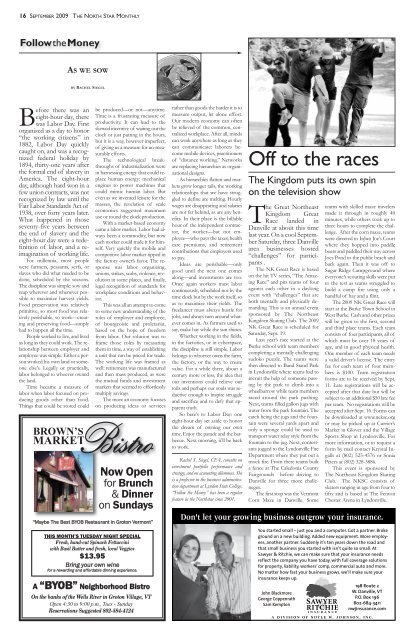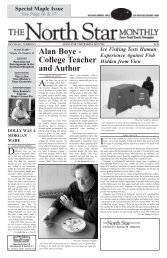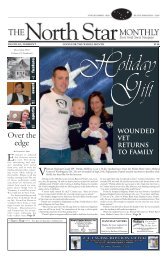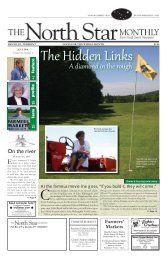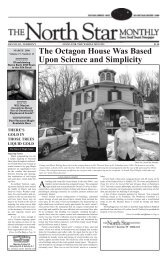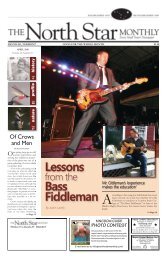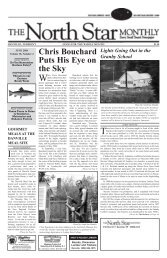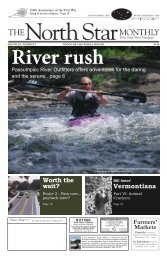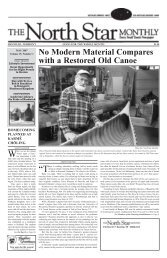Eyes ofHistory - The North Star Monthly
Eyes ofHistory - The North Star Monthly
Eyes ofHistory - The North Star Monthly
You also want an ePaper? Increase the reach of your titles
YUMPU automatically turns print PDFs into web optimized ePapers that Google loves.
16 SEPTEMBER 2009 THE NORTH STAR MONTHLY<br />
FollowtheMoney<br />
BROW�’S<br />
MARKET<br />
AS WE SOW<br />
BY RACHEL SIEGEL<br />
Before there was an<br />
eight-hour day, there<br />
was Labor Day. First<br />
organized as a day to honor<br />
“the working citizens” in<br />
1882, Labor Day quickly<br />
caught on, and was a recognized<br />
federal holiday by<br />
1894, thirty-one years after<br />
the formal end of slavery in<br />
America. <strong>The</strong> eight-hour<br />
day, although hard won in a<br />
few union contracts, was not<br />
recognized by law until the<br />
Fair Labor Standards Act of<br />
1938, over forty years later.<br />
What happened in those<br />
seventy-five years between<br />
the end of slavery and the<br />
eight-hour day were a redefinition<br />
of labor, and a reimagination<br />
of working life.<br />
For millennia, most people<br />
were farmers, peasants, serfs, or<br />
slaves who did what needed to be<br />
done, scheduled by the seasons.<br />
<strong>The</strong> discipline was simple: sow and<br />
reap wherever and whenever possible<br />
to maximize harvest yields.<br />
Food preservation was relatively<br />
primitive, so most food was relatively<br />
perishable, so work—creating<br />
and preserving food—simply<br />
had to happen all the time.<br />
People worked to live, and lived<br />
as long as they could work. <strong>The</strong> relationship<br />
between employer and<br />
employee was simple. Either a person<br />
worked his own land or someone<br />
else’s. Legally or practically,<br />
labor belonged to whoever owned<br />
the land.<br />
Time became a measure of<br />
labor when labor focused on producing<br />
goods other than food.<br />
Things that could be stored could<br />
be produced—or not—anytime.<br />
Time is a frustrating measure of<br />
productivity. It can lead to the<br />
skewed incentive of waiting out the<br />
clock or just putting in the hours,<br />
but it is a way, however imperfect,<br />
of giving us a measure for un-measurable<br />
efforts.<br />
<strong>The</strong> technological breakthroughs<br />
of industrialization were<br />
in harnessing energy that could replace<br />
human energy: mechanical<br />
engines to power machines that<br />
could mimic human labor. But<br />
even as we invented leisure for the<br />
masses, the revelation of scale<br />
economies suggested maximum<br />
use or round the clock production.<br />
With a market-based economy<br />
came a labor market. Labor had always<br />
been a commodity, but now<br />
each worker could trade it for himself.<br />
Very quickly the mobile and<br />
competitive labor market tipped in<br />
the factory owner’s favor. <strong>The</strong> response<br />
was labor organizing,<br />
unions, strikes, scabs, violence, revolution<br />
in some places, and finally,<br />
legal recognition of standards for<br />
workplace conditions and behavior.<br />
This was all an attempt to come<br />
to some new understanding of the<br />
roles of employer and employee,<br />
of bourgeoisie and proletariat,<br />
based on the hope of freedom<br />
from labor. Our solution was to<br />
frame those roles by measuring<br />
them in time, a way of establishing<br />
a unit that can be priced for trade.<br />
<strong>The</strong> working life was framed as<br />
well: retirement was manufactured<br />
and then mass produced, as were<br />
the mutual funds and investment<br />
markets that seemed to effortlessly<br />
multiply savings.<br />
<strong>The</strong> more an economy focuses<br />
on producing ideas or services<br />
Now Open<br />
for Brunch<br />
& Dinner<br />
on Sundays<br />
"Maybe <strong>The</strong> Best BYOB Restaurant in Groton Vermont”<br />
THIS MONTH’S TUESDAY NIGHT SPECIAL<br />
Fresh, hand-cut Spinach Fettuccini<br />
with Basil Butter and fresh, local Veggies<br />
$13.95<br />
Bring your own wine<br />
for a rewarding and affordable dinning experience.<br />
A “BYOB” Neighborhood Bistro<br />
On the banks of the Wells River in Groton Village, VT<br />
Open 4:30 to 9:00 p.m., Tues - Sunday<br />
Reservations Suggested 802-584-4124<br />
rather than goods the harder it is to<br />
measure output, let alone effort.<br />
Our modern economy can often<br />
be relieved of the common, centralized<br />
workplace. After all, minds<br />
can work anywhere as long as they<br />
can communicate: laborers become<br />
mobile devices, practitioners<br />
of “distance working.” Networks<br />
are replacing hierarchies as organizational<br />
designs.<br />
As hierarchies flatten and markets<br />
grow longer tails, the working<br />
relationships that we have struggled<br />
to define are melting. Hourly<br />
wages are disappearing and salaries<br />
are not far behind, as are any benefits.<br />
In their place is the billable<br />
hour of the independent contractor,<br />
the worker—but not employee—who<br />
pays the taxes, health<br />
care premiums, and retirement<br />
contributions that employers used<br />
to pay.<br />
Ideas are perishable—only<br />
good until the next one comes<br />
along—and investments are too.<br />
Once again workers must labor<br />
continuously, scheduled not by the<br />
time clock but by the work itself, so<br />
as to maximize their yields. <strong>The</strong><br />
freelancer must always hustle for<br />
jobs, and always turn around whatever<br />
comes in. As farmers used to<br />
say, make hay while the sun shines.<br />
Whether working in the fields,<br />
in the factories, or in cyberspace,<br />
the discipline is still simple. Labor<br />
belongs to whoever owns the farm,<br />
the factory, or the way to create<br />
value. For a while there, about a<br />
century more or less, the idea that<br />
our inventions could relieve our<br />
toils and perhaps our souls was seductive<br />
enough to inspire struggle<br />
and sacrifice and to defy that apparent<br />
truth.<br />
So here’s to Labor Day: one<br />
eight-hour day set aside to honor<br />
the dream of owning our own<br />
time. Enjoy the parade and the barbecue.<br />
Next morning, it’ll be back<br />
to work.<br />
Rachel S. Siegel, CFA, consults on<br />
investment portfolio performance and<br />
strategy, and on accounting dilemmas. She<br />
is a professor in the business administration<br />
department at Lyndon State College.<br />
“Follow the Money” has been a regular<br />
feature in the <strong>North</strong>star since 2001.<br />
Off to the races<br />
<strong>The</strong> Kingdom puts its own spin<br />
on the television show<br />
<strong>The</strong> Great <strong>North</strong>east<br />
Kingdom Great<br />
Race landed in<br />
Danville at about this time<br />
last year. On a cool September<br />
Saturday, three Danville<br />
area businesses hosted<br />
“challenges” for participants<br />
.<br />
<strong>The</strong> NK Great Race is based<br />
on the hit TV series, “<strong>The</strong> Amazing<br />
Race” and pits teams of four<br />
against each other in a daylong<br />
event with “challenges” that are<br />
both mentally and physically demanding.<br />
This is an annual event<br />
sponsored by <strong>The</strong> <strong>North</strong>east<br />
Kingdom Skating Club. <strong>The</strong> 2009<br />
NK Great Race is scheduled for<br />
Saturday, Sept. 19.<br />
Last year’s race started at the<br />
Burke school with team members<br />
completing a mentally challenging<br />
sudoko puzzle. <strong>The</strong> teams were<br />
then directed to Band Stand Park<br />
in Lyndonville where teams had to<br />
recruit the help of someone passing<br />
by the park to climb into a<br />
wheelbarrow while team members<br />
raced around the park pushing.<br />
Next, teams filled gallon jugs with<br />
water from the park fountain. <strong>The</strong><br />
catch being the jugs and the fountain<br />
were several yards apart and<br />
only a sponge could be used to<br />
transport water relay style from the<br />
fountain to the jug. Next, contestants<br />
jogged to the Lyndonville Fire<br />
Department where they put out a<br />
mock fire. From there teams built<br />
a fence at <strong>The</strong> Caledonia County<br />
Fairgrounds before driving to<br />
Danville for three more challeneges.<br />
<strong>The</strong> first stop was the Vermont<br />
Corn Maze in Danville. Some<br />
Don’t let your growing business outgrow your insurance.<br />
You started small – just you and a computer. Got a partner. Broke<br />
ground on a new building. Added new equipment. More employees,<br />
another partner. Suddenly it’s ten years down the road and<br />
that small business you started with isn’t quite so small. At<br />
Sawyer & Ritchie, we can make sure that your insurance needs<br />
reflect the company you have today, with full coverage solutions<br />
for property, liability, workers’ comp, commercial auto and more.<br />
No matter how fast your business grows, we’ll make sure your<br />
insurance keeps up.<br />
John Blackmore<br />
George Coppenrath<br />
Sam Kempton<br />
teams with skilled maze travelers<br />
made it through in roughly 40<br />
minutes, while others took up to<br />
three hours to complete the challenge.<br />
After the corn maze, teams<br />
were directed to InJun Joe’s Court<br />
where they hopped into paddle<br />
boats and paddled their way across<br />
Joes Pond to the public beach and<br />
back again. <strong>The</strong>n it was off to<br />
Sugar Ridge Campground where<br />
everyone’s scouting skills were put<br />
to the test as teams struggled to<br />
build a camp fire using only a<br />
handful of hay and a flint.<br />
<strong>The</strong> 2009 NK Great Race will<br />
start at the Burke Town School in<br />
West Burke. Cash and other prizes<br />
will be given to the first, second<br />
and third place teams. Each team<br />
consists of four participants, all of<br />
which must be over 18 years of<br />
age, and in good physical health.<br />
One member of each team needs<br />
a valid driver’s license. <strong>The</strong> entry<br />
fee for each team of four members<br />
is $100. Team registration<br />
forms are to be received by Sept.<br />
11. Late registrations will be accepted<br />
after that date but will be<br />
subject to an additional $50 late fee<br />
per team. No registrations will be<br />
accepted after Sept. 16. Forms can<br />
be downloaded at www.neksc.org<br />
or may be picked up at Currier’s<br />
Market in Glover and the Village<br />
Sports Shop in Lyndonville. For<br />
more information, or to request a<br />
form by mail contact Krystal Ingalls<br />
at (802) 525-4576 or Sonia<br />
Peters at (802) 328-3886.<br />
This event is sponsored by<br />
<strong>The</strong> <strong>North</strong>east Kingdom Skating<br />
Club. <strong>The</strong> NKSC consists of<br />
skaters ranging in age from four to<br />
fifty and is based at <strong>The</strong> Fenton<br />
Chester Arena in Lyndonville.<br />
198 Route 2<br />
W. Danville, VT<br />
P.O. Box 196<br />
802-684-3411<br />
nwjinsurance.com<br />
A DIVISION OF NOYLE W. JOHNSON, INC.


